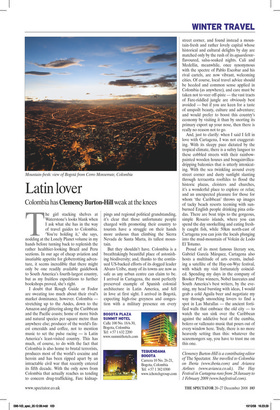Latin lover
Colombia has Clemency Burton-Hill weak at the knees The girl stacking shelves at Waterstone’s looks blank when I ask what she has in the way of travel guides to Colombia. ‘You’re holding it,’ she says, nodding at the Lonely Planet volume in my hands before turning back to replenish the rather healthier-looking Brazil and Peru sections. In our age of cheap aviation and insatiable appetite for globetrotting adventure, it seems incredible that there might only be one readily available guidebook to South America’s fourth-largest country, but as my fruitless expeditions to further bookshops proved, she’s right.
I doubt that Rough Guide or Fodor are sweating too much about their rival’s market dominance, however. Colombia — stretching up to the Andes, down to the Amazon and glittering along the Caribbean and the Pacific coasts; home of more birds and natural species per square metre than anywhere else; producer of the world’s finest emeralds and coffee, not to mention music to set the pulse racing — is Latin America’s least-visited country. This has much, of course, to do with the fact that Colombia is also home to brutal terrorists, produces most of the world’s cocaine and heroin and has been ripped apart by an intractable civil war that recently entered its fifth decade. With the only news from Colombia that actually reaches us tending to concern drug-trafficking, Farc kidnap pings and regional political grandstanding, it’s clear that those unfortunate people charged with promoting their country to tourists have a struggle on their hands more arduous than climbing the Sierra Nevada de Santa Marta, its tallest mountain.
But they shouldn’t have. Colombia is a breathtakingly beautiful place of astonishing biodiversity; and, thanks to the continued US-backed efforts of its dogged leader Alvaro Uribe, many of its towns are now as safe as any urban centre can claim to be. I arrived in Cartagena, the most perfectly preserved example of Spanish colonial architecture in Latin America, and fell in love at first sight. I arrived in Bogotá, expecting high-rise greyness and congestion with a military presence on every street corner, and found instead a mountain-fresh and rather lovely capital whose historical and cultural delights by day are matched only by the rush of its aguardienteflavoured, salsa-soaked nights. Cali and Medellin, meanwhile, once synonymous with the spectre of Pablo Escobar and his rival cartels, are now vibrant, welcoming cities. Of course, local travel advice should be heeded and common sense applied in Colombia (as anywhere), and care must be taken not to veer off-piste — the vast tracts of Farc-riddled jungle are obviously best avoided — but if you are keen for a taste of unspoilt beauty, culture and adventure; and would prefer to boost this country’s economy by visiting it than by snorting its primary export up your nose, then there is really no reason not to go.
And, just to clarify: when I said I fell in love with Cartagena, I was not exaggerating. With its sleepy pace dictated by the tropical climate, there is a sultry languor to these cobbled streets with their rainbowpainted wooden houses and bougainvilleadripping balconies that is utterly intoxicating. With the sea twinkling around every street corner and dusty sunlight slanting through terracotta rooftiles to flood the historic plazas, cloisters and churches, it’s a wonderful place to explore or relax; and an unexpected pleasure for those for whom ‘the Caribbean’ throws up images of tacky beach resorts teeming with sunburned English people drinking pina coladas. There are boat trips to the gorgeous, simple Rosario islands, where you can spend the day snorkelling and eating freshly caught fish, while 50km north-east of Cartagena you can join the locals plunging into the mud-mountain of Volcán de Lodo El Totumo.
Proud of its most famous literary son, Gabriel García Márquez, Cartagena also hosts a multitude of arts events, including a satellite of the Hay-on-Wye festival, with which my visit fortunately coincided. Spending my days in the company of Booker Prize winners, Nobel laureates and South America’s best writers, by the evening, my head bursting with ideas, I would grab a cold Aguila beer and negotiate my way through smooching lovers to find a spot in Las Murallas — the ancient fortified walls that embrace the old city — to watch the sun sink over the Caribbean against the addictive beat of the cumbia, bolero or vallenato music that pours out of every window here. Truly, there is no more heavenly setting than this: whatever the scaremongers say, you have to trust me on this one.






















































































































 Previous page
Previous page